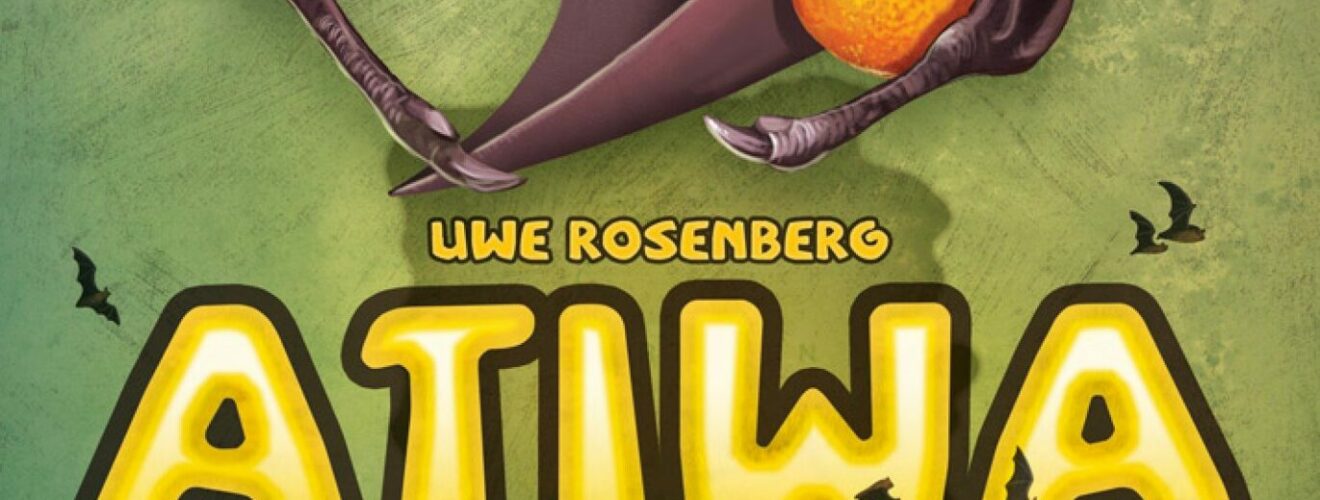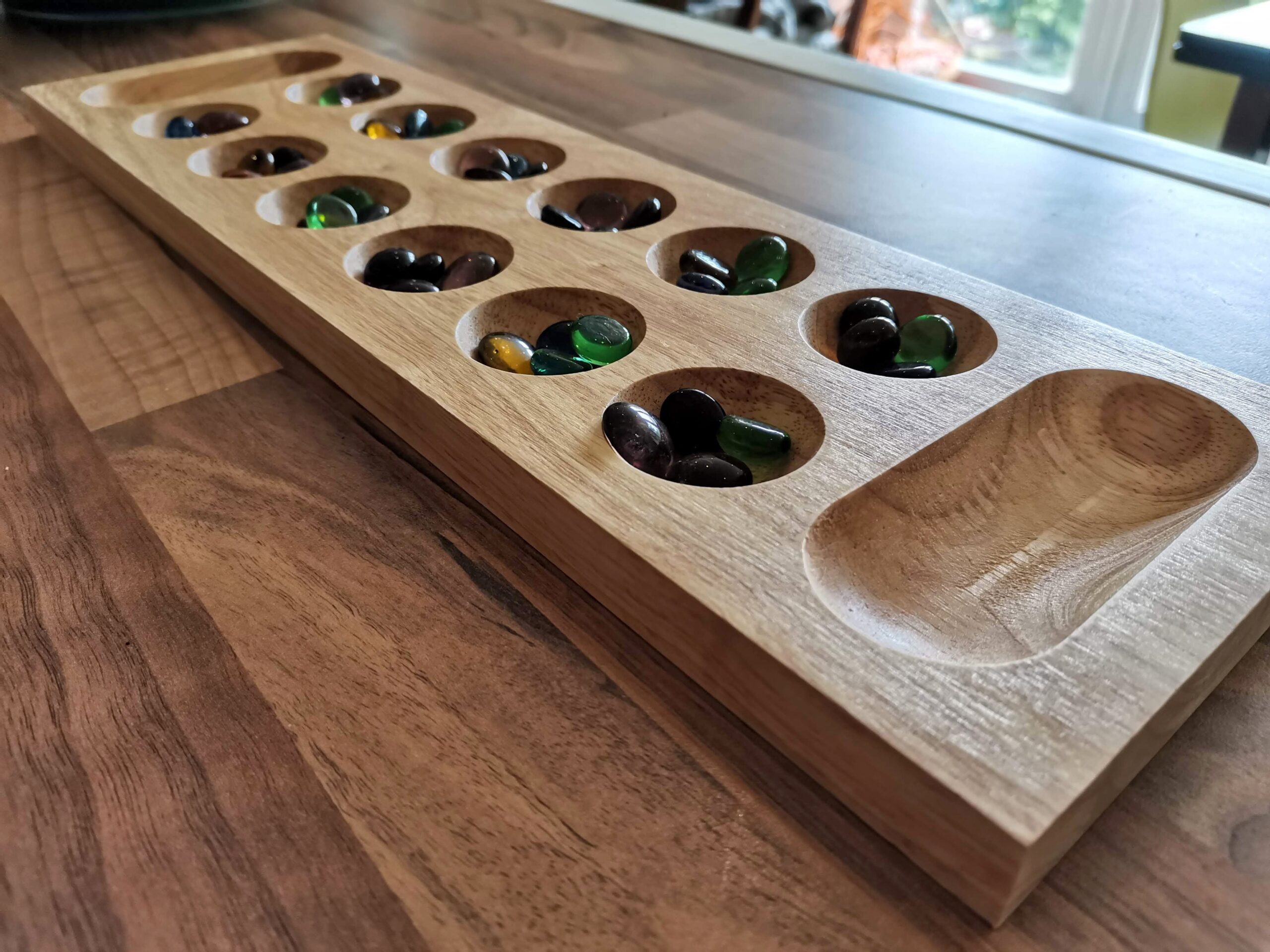Atiwa Review

Atiwa hit shelves after a successful launch at Essen Spiel ’22. It’s a game about bats, and you know what? I think it might be my favourite Uwe Rosenberg game.
A tricky act to follow
For me, Uwe Rosenberg has a habit of creating games that fall into one of three categories. First up are the clever, lighter puzzles of games like Patchwork and Nova Luna. Then you get the brain-grinding agony of choice from the likes of A Feast For Odin and Hallertau (review here). My favourites from his stable are the games that sit between the two. Fun puzzles which don’t overwhelm you with choice, but with their roots firmly in the Euro game soil. Nusfjord (review here) remains one of my favourite games ever, but now there’s a new kid on the block, making some noise.
And the noise that the new kid is making is a high-pitched squeaking noise.

You see, Atiwa is a game about bats. I mean, if you want to be pedantic, it’s about developing a small community in the Atiwa Range area of Ghana. But really it’s about bats. Loads and loads of outrageously cute bat meeples. I’m a little bit in love with the bats. As I mentioned above, Atiwa isn’t anything as like as heavy as A Feast For Odin, and while it’s lighter than Hallertau, there are plenty of familial traits passed down through its genes.
Perhaps the biggest difference between Atiwa and Uwe’s previous games is that it does away with cards. You’ll add big, square cards to your tableau, but these are more like tiles than playing cards. If you’ve played the likes of Nusfjord, Hallertau, Caverna, and Agricola, you’ll know that his games traditionally have a lot of cards in them, often with different decks to spice things up. Not so in Atiwa. Other than the tile-card hybrids, there are none.
Thicker than skin-deep
As you might expect, Atiwa is a worker-placement game. Each player only has three workers to place, and there are a lot of things you’ll want to do, so there’s some strategy needed. The bats I mentioned are at the heart of the action. Developing your community’s tiles gives you space to add family buildings, and there’s space for goats and wild animals to flourish (people have got to eat), and areas where trees grow. Trees grow fruit on them, and at the end of each turn if you have three or more bats on your boards you can ‘pay’ a fruit to send them off for the night, leaving your board for the round, but growing a tree elsewhere.

It’s a nice thematic touch which ties right back to the origins of the game, which has its roots in reality. The story goes that the mayor of a nearby town was looking after the fruit bats, giving them shelter. Those bats then flew off at night, looking for fruit, and the seeds that fell in the guano (bat poop) helped to reforest whole swathes of land. This mechanism runs through the core of the game.
Look after the bats > Bats eat the fruit > Bats poop out the fruit seeds > New trees grow.
It’s another great example of Uwe Rosenberg not just leaping on the back of a concept, hoping if he whacks it hard enough it’ll carry him where he needs to get to. Every single thing in the game comes from the real world. At the end of a round when you come to feed your family, if you can’t manage it you draw pollution tiles, which represent the mining in the area. You might turn up gold if you’re lucky, but at the expense of a spot on your boards, and that can be a real hindrance. Untrained families can even eat the bats as bushmeat, but if you train those families, they’ll earn gold during income.
Action stations
At first glance, you might think the board rivals something like A Feast For Odin in terms of action spaces to place your workers. In reality, the choices are much more simple. Many of the actions involve moving something from your supply board (goats, wildlife, trees, families, fruit) to your village spaces, usually by trading something else in return. The game’s economy is really easy to grasp. Above and below the main board are new tiles to add to your tableau, representing wild areas (things like grasslands, lakes, caves), or living areas such as villages and towns. Expanding your tableau with these tiles is essential as the game goes on.

There’s plenty of competition for the available spaces, and it’s another of Uwe’s games that asks you to have at least two or three plans in mind, because sod’s law says someone is going to take the spot you want. I really like the inclusion of the action tiles – vertical tiles which slide to the left each round, both tracking the rounds of the game, and offering different action combinations each time they move. The way the game presents itself means each player is trying to do mostly the same things for most of the game. There’s enough wiggle room as the game progresses for some divergent strategies, but the basics of the game and the things you need to do really help to introduce the game to new players.
I’ve not seen an absolute runaway winner yet in quite a few games, which speaks volumes about the level of balance in the game. It’s easy to get complacent about such things, but after Hallertau when some players complained that it was just a case of ‘solving’ the puzzle to move the community centre in the game, it’s great to see another game which feels open-ended.
Final thoughts
Atiwa came out of nowhere for a lot of people, and the box art looks goofy as heck. There’s a lot of charm in there though, and the cutesy cover bat is one of the game’s most telling features. Atiwa feels like a much friendlier game than many of its predecessors. For instance, Agricola is commonly called Misery Farm Simulator because it’s so tight and so harsh. Hallertau is almost there with the components and farming board, but the action spaces are so regimented in their plain grid, it looks like a playtest version which slipped through to the printers. Atiwa absolutely nails it, from the box art right down to the board itself. It’s colourful and vibrant, it’s friendly-looking, and the iconography is clear and pronounced.
Ditching the cards was the genius move from Uwe with this game. Without having to manage a hand of cards with various professions, skills, bonuses or what have you, it leaves you free to concentrate on the table in front of you, and in turn it makes it a much more accessible game. I took Atiwa to my local game group and played with three others who’d never even touched an Uwe Rosenberg game before. Within one round, everybody understood what was going on, and how to get what they wanted, more or less. For that reason alone it usurps Nusfjord from the top of my ‘easier Uwe worker-placement game to teach to a group‘ list. It’s a pretty niche list, granted, but that position is a lofty one.
As is often the case with his games, the solo mode is excellent. It leans on many of its forebears and employs the ‘leave workers from a previous round blocking spaces’ mechanism, which works elegantly. Beware the solo challenges in the rulebook – they’re crazy difficult. As a solo game though, it’s a real hit, and among the very best of ‘Beat Your Own Score’ games.
It’ll come as no surprise to you by now that I love Atiwa. I loved it after my first play at Gridcon last year, and that love has only grown. Part of my love is because the components are so adorable, part of it is the ease of play, and part is of how streamlined it is. Solo will take you half an hour, then you can reset in a couple of minutes and go again (steady now!). How many games can you say that about? Time will tell, I’m sure, but as I write this now, Atiwa is my favourite Uwe Rosenberg game, just edging out Nusfjord. I’m sorry my fishy friend, I love you dearly, but these bats are just too much. Atiwa is a wonderful game.
Review copy provided by Kienda.co.uk. Thoughts and opinions are my own.
If you like the look of Atiwa, you can buy it at Punchboard’s retail partner, Kienda. If you sign-up for your account with my link – kienda.co.uk/punchboard – you’ll save 5% off your first purchase totalling £60.

Atiwa (2022)
Designer: Uwe Rosenberg
Publisher: Lookout Games
Art: Andy Elkerton
Players: 1-4
Playing time: 30-120 mins














thanks for excellent review, how about the replayability of the game (for solo only)?
Like most other Uwe Rosenberg solo modes, it’s a case of trying to score well as you solve the puzzle. If that’s what you enjoy, it’s great. Nusfjord is still my favourite solo game of his, but Atiwa is good fun too.